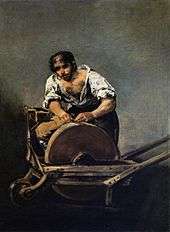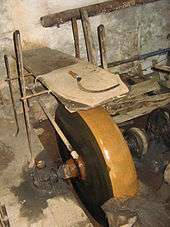Grindstone
A grindstone is a round sharpening stone used for grinding or sharpening ferrous tools. Grindstones are usually made from sandstone.[2][3] Grindstone machines usually have pedals for speeding up and slowing down the stone to control the sharpening process. The earliest known representation of a rotary grindstone,[4] operated by a crank handle, is found in the Carolingian manuscript known as the Utrecht Psalter. This pen drawing from about 830 goes back to a late antique original.[5] The Luttrell Psalter, dating to around 1340, describes a grindstone rotated by two cranks, one at each end of its axle.[6] Around 1480, the early medieval rotary grindstone was improved with a treadle and crank mechanism.[7]

The Knife-grinder by Goya shows a man using a portable grindstone.

Large waterwheel powered grindstone. The user would lie on the plank above the grindstone while grinding metal items, giving rise to the phrase nose to the grindstone.[1]
See also
References
- Grindstones, archived from the original on 2006-01-17, retrieved 2010-02-10.
- Knight, Edward Henry (1876), Knight's American mechanical dictionary, Houghton, Mifflin, pp. 1022–1023.
- White, Jr. 1962, p. 110
- Hägermann & Schneider 1997, pp. 425f.
- White, Jr. 1962, p. 111
- White, Jr. 1962, p. 167
Sources
- Hägermann, Dieter; Schneider, Helmuth (1997), Propyläen Technikgeschichte. Landbau und Handwerk, 750 v. Chr. bis 1000 n. Chr. (2nd ed.), Berlin, ISBN 3-549-05632-X
- White, Jr., Lynn (1962), Medieval Technology and Social Change, Oxford: At the Clarendon Press
| Wikimedia Commons has media related to Grinding stones. |
This article is issued from Wikipedia. The text is licensed under Creative Commons - Attribution - Sharealike. Additional terms may apply for the media files.